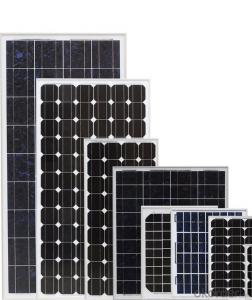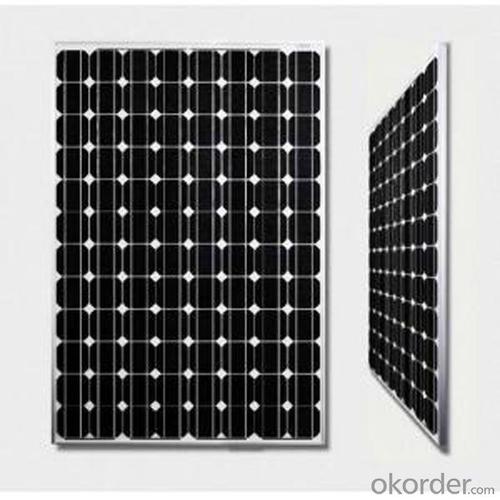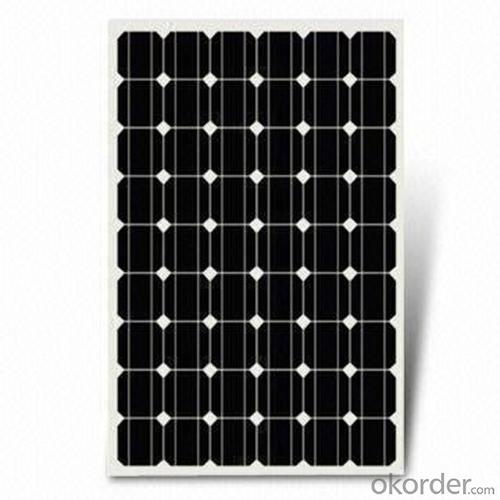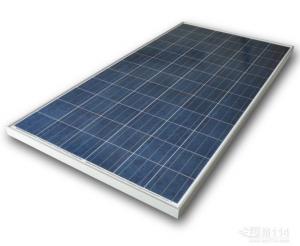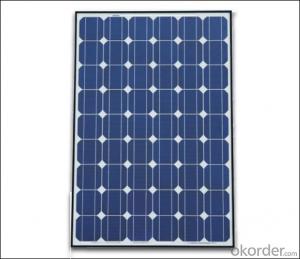Most Efficient 240w A Grade Solar Panels for Home - China's Top Manufacturers
- Loading Port:
- China main port
- Payment Terms:
- TT OR LC
- Min Order Qty:
- 10000 watt
- Supply Capability:
- 100000000 watt/month
OKorder Service Pledge
OKorder Financial Service
You Might Also Like
Specification
Description
High cell efficiency PV solar panel with quality silicon material for long term output stability and reliability.
Rigorous quality control to meet the highest international standards.
High transmittance, low iron tempered glass with enhanced stiffness and impact resistance.
Unique frame design with high mechanical strength for easy installation.
Advanced encapsulation material with multilayer sheet lamination to provide long-life and enhanced cell performance.
Outstanding electrical performance under high temperature and low irradiance conditions.
48 Back-Contact monocrystalline Si solar cells (approx. 18.35%).
Our Advantages
Long Service Life
2.High Efficiency Solar Cells
3.Special Aluminum Frame Design
4.High Transmission, Low Iron Tempered Glass
5.Advanced Cell Encapsulation .
Solar System characteristic:
1. All Systems have LCD digital display which allows you to see the system working, (eg) Charge data, System voltage, Daily power consumption and temperature.
2. All type of BPS system both has AC and DC output.
3. All system have automatic switch , If mains power goes off the system will switch automatically over to battery power, When mains power resumes
the system will switch back automatically. The batteries will resume recharging automatically.
4. All inverters are Pure Sine Wave inverters. This allows the use of Air Conditioners and refrigerators without any problem.
5. Each component has a single chip detector. Assembled by the IPM or IGBT of Mitsubishi
This protects the system from Overloads, Low Voltage and Under Voltage (alarm) Over Heating, Short circuit, Reverse Polarity.
Product details show
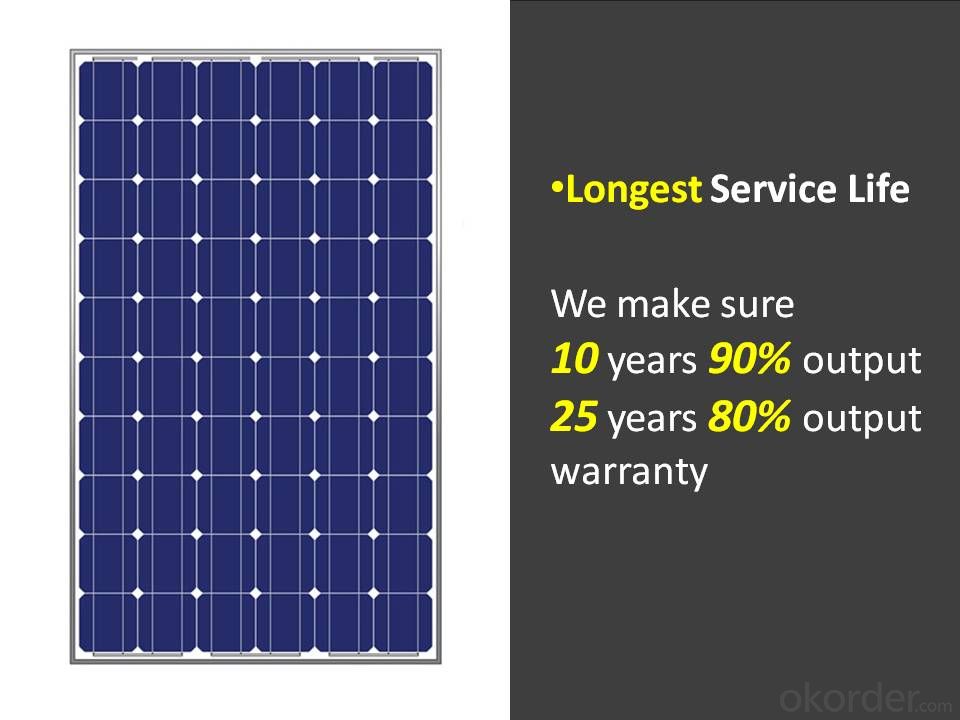





Our Service
1. We will reply with in 24 workingday hours.
2. The size and voltage of solar panels can be customized by customers' requirements.
3. Professional manufacturer. You are warmly welcomed to visit us!
4. We have a professional engineers team, we can answer your questions about our products.
5. Each step after many tests to ensure that the panel can work normally.
6. We will be offer a good discount for big amount.
- Q: Can solar panels be installed on assisted living facilities?
- Yes, solar panels can be installed on assisted living facilities. In fact, installing solar panels on these buildings can be highly beneficial as it can help reduce energy costs, promote sustainability, and contribute to a greener environment. Additionally, solar panels can provide a reliable source of renewable energy, helping to ensure a more reliable power supply for the facility and its residents.
- Q: solar panels!!they are fantastic! cause they are the new way of quot;chargingyour home, without killing the earth!would you install them, or not? and make sure you say WHY
- I believe the best economy comes out when a completely green house is built. Solar panels are expensive, and I'll rather use some of the investments to build different back-up systems, instead of bying solar panels for it all. If I build another house, my fancy stuff would be the green stuff. The house will have a water radiator heating system and a heat pump to circulate warm or cold air in the house. Heat pump also used to heat water for heating system. I'll use solar panels to make enough electric power . charging a deep cycle battery pack for back up power, 2. to power heat pump, fridges., freezers, and water pumps, when I'm not home at the house. When I'm home I'll run a bio-fueled(bio-waste and pellets or firewood) powered steam engine with a 0KW 0-220V generator when I need electric stove and oven, dishwasher and laundry appliances. I'll use a wood stove, BBQ and oven on the porch for summer cooking. I'll use excessive heat from steam engine for heating water tank. I'll also have an bio-fueled (waste and pellets or firewood) water heater for winter heating back-up. Of course I'll make sure I'm connected to the electric grid, so I can get credit from power company for the excessive electricity that will occasionally come out from solar panels. Steam engine can be replaced by diesel powered 0KW generator, if it's possible to fuel it with veg-oil home made diesel fuel. Depends whats most accessible at my living site.
- Q: What is the environmental impact of solar panels?
- Solar panels have a positive environmental impact as they generate clean and renewable energy. They reduce greenhouse gas emissions, air pollution, and dependence on fossil fuels, mitigating climate change and improving air quality. However, their production and disposal do have some environmental impact, including resource extraction and waste management, but these impacts are significantly lower compared to conventional energy sources.
- Q: Solar panels are expensive,can I make my own solar panel?
- no, not really, they require exotic chemicals and processes. The online outfits that promise to help you build your own are mostly scams. The one I looked at (other answer) seems to just be an assembly guide to put together solar cells into panels. That is fine, but you still have to buy the solar cells, the expensive part. The assembly is just putting them in series/parallel to produce higher voltages and currents. .
- Q: i want to instal solar ligth in my garden
- hello, okorder /
- Q: I paid for an appraisal and the home was valued at $25,000. The problem I have with this is my house is equipped with solar panels. I paid about $25000 for them. A comparable house sold for $225,000 4 months ago. Same amount of rooms, bathrooms, square feet, lot size and curb appeal (landscaping). But no solar panels. Home prices in my neighborhood have also gone up. I would like to know if there is any way I can dispute this as I feel I just wasted a lot of money on a incorrect appraisal.
- Zillow appraisal is useless and not at all important. If you are selling your home then the solar installation should give you some advantage, depending on how much you are still paying for utilities. The only appraisal that matters is the one a buyer gets to lock in a mortgage. Nothing else matters.
- Q: Can solar panels be used for powering a museum or cultural institution?
- Yes, solar panels can certainly be used to power a museum or cultural institution. Solar panels are a sustainable and renewable energy source that can generate electricity by converting sunlight into usable power. By installing solar panels on the rooftops or surrounding areas of a museum or cultural institution, it is possible to produce clean energy that can be used to power the building's lighting, heating, cooling systems, and other electrical needs. This not only reduces the institution's carbon footprint but also helps save on energy costs in the long run. Additionally, solar panels can serve as a visible symbol of the institution's commitment to environmental sustainability, inspiring visitors and the community to embrace renewable energy solutions.
- Q: We have LED at the output of 40 watts and is used for 0 hours giving us 400 Watts-hr of energy consumed.Rechargable batteries needed are 2 V. 400/2 gives us 34 Ampere-hour battery needed. If we want it for 3 days, It would be 34x3=00 Ah. So the battery needed 00 AhNow how do I select the solar panel which can charge this/these batteries? What should be its rating?
- Be aware that you cannot discharge the full capacity of a lead-acid battery without destroying the battery. With a normal battery of this type, you would only want to discharge about 20%, so you would need a 70 AH battery bank. For the 3-day requirement, 500 AH. This is still within reason. If you didn't have the 3-day requirement, you might consider going with NiMH batteries. Back to the 500 AH bank, you would usually charge at at least 5% C, or 25 amps. At the 5 volts that you need for charging, this is 375 watts. Possibly you could go as low as 200 watts.
- Q: It measured volts before I attached it, and after attaching the voltage regulator device, the voltage dropped down to 3 volts, even when just measuring the difference in the solar panels nodes themselves, suggesting that the entire panels voltage dropped and not just the voltage in the regulator. I tried testing it with a power supply of 7 V 0. A and it works fine, but I don't know why it won't work for the solar panel.
- you cannot treat the open circuit voltage of a solar panel like a voltage source (like a battery.) the load response of the panel doesn't behave that way. small panels and panels that are producing less than about .5A are very happy to have their output voltage pulled down to whatever they're connected to (typically zero.) I observed the same phenomenon when i connected a 2V 725mA panel to a 2V 325mA fan -- the open circuit voltage of 5V dropped to 3V when connected to the fan, and returned to 5V when disconnected. The easiest workaround is to use 2V of rechargable batteries in parallel with the panel so that the battery holds the 2V potential difference and the panel just supplies the current. any excess current charges the batteries, so you might consider whether or not you need some type of charge controller to prevent burning the batteries via overcharging. there are actually very few applications of solar panels connected directly to circuits that i have seen that have any kind of robust performance -- if they work at all, they eventually die/burn themselves out in a couple of months. the best robust designs always have a rechargable battery and charge controller somewhere in the power circuitry to buffer the load circuit from the panel. .
- Q: Solar panel for battary charging
- What you are stating is that the battery you have will operate the UPS for about 2 hours before it is drained past the point of no return (technically 2.82 hours, but that would be a dead battery - most well-designed UPS systems cut off when the battery gets below about a 30% charge so that battery is not damaged. Lead-Acid batteries have about a 0%/month self-discharge rate if there is no load connected. The very best systems are as low as 3%, the worst are over 20% - and all at a 'normal' temperature. So, you will need a maintenance charger of about ten (0) watts or so - amp will be more than enough. And about any solar panel will handle that much with the proper charging connection.
Send your message to us
Most Efficient 240w A Grade Solar Panels for Home - China's Top Manufacturers
- Loading Port:
- China main port
- Payment Terms:
- TT OR LC
- Min Order Qty:
- 10000 watt
- Supply Capability:
- 100000000 watt/month
OKorder Service Pledge
OKorder Financial Service
Similar products
Hot products
Hot Searches
Related keywords



